CompassionLab scholarship draws attention to suffering as an “inevitable, ubiquitous, yet often overlooked aspect of organizational life (Lilius et al., 2011). Because “pain and compassion are not separate from ‘being a professional’ and the ‘doing of work’ in organizations,” (Frost et al., 2000) our scholarship focuses on organizations as “sites of everyday healing and pain” (Frost et al., 2000).
We know that “organizations as behavioral settings case ease or make more difficult people’s compassion giving” (Frost et al., 2000). Our research “has contributed to our understanding of the nature of compassion and suffering in organizations and of the powerful effects of compassion on those who receive it, witness its accomplishments, and are involved in its delivery” (Lilius et al., 2012).
Compassion is the heart’s response to this suffering. Compassion—from the roots passio (suffering) and com (with) — means to suffer with another. Compassion is an innate part of human response to suffering, which is comprised of a three-part experience of noticing another’s pain, feeling with another, and responding in some way (see Kanov et al., 2004).
The CompassionLab has worked to trace the forms of compassion at work and to map its consequences. The most common forms of compassion at work seem to be providing emotional support, offering flexibility with work time, and giving material goods that are both helpful and symbolic of concern (see Lilius et al., 2008). The experience of compassion include changes in the way people think about themselves and the way they see their coworkers—compassion builds bonds between people. Experiencing compassion at work can also change the way people see the entire organization as a more caring place, and heighten both their positive emotions and organizational commitment (Lilius et al., 2008).
As organizational researchers, the CompassionLab has worked to develop theoretical explanations about how compassion can become organized and spread throughout human systems. In a fine-grained case study of a response to a fire, we found that compassion as a collective response becomes organized through a combination of 1) networks of people who know one another well enough to share information about pain and suffering; 2) routines for service or hospitality, which foster regularity in human contact; and 3) values such as shared humanity (see Dutton et al., 2006). In addition, the actions of leaders affect how much compassion spreads in an organization, while the actions of impromptu coordinators is important for coordinating and customizing responses to suffering.
The CompassionLab continues to study the expression of compassion in workplaces to learn more about how compassion is organized in human systems (Frost et al., 2006). We need to know more about how organizations become can responsive to suffering and therefore can also enable healing.
